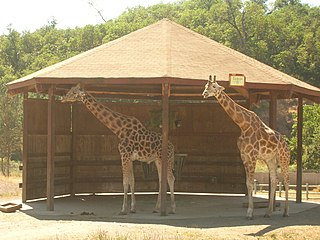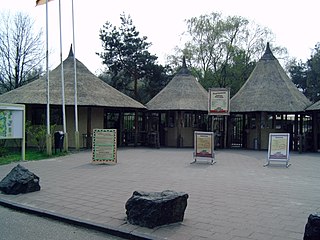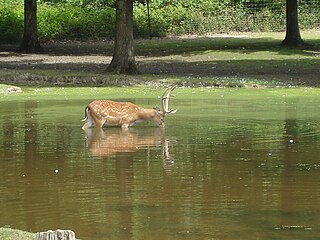
The Berlin Zoological Garden is the oldest surviving and best-known zoo in Germany. Opened in 1844, it covers 35 hectares and is located in Berlin's Tiergarten. With about 1,380 different species and over 20,200 animals, the zoo presents one of the most comprehensive collections of species in the world.

Goldau is a town in the community of Arth, canton of Schwyz, Switzerland. It lies between the Rigi and Rossberg mountains, and between lakes Zug and Lauerz. Well known attractions include the Natur- und Tierpark Goldau and the Arth-Goldau valley station of the Arth-Rigi Bahn connecting to the Rigi mountain.

Wildlife Safari is a drive-through safari and zoological park in Winston, Oregon, United States. The park’s main draw are the 615-acre (249 ha) pastures and field enclosures which visitors drive their own vehicles through, enabling many up-close animal encounters and photo opportunities. These expansive field exhibits, divided into regions such as Africa, Asia and the Americas, mainly feature the park’s ungulate herds and larger hoofed mammals, as well as larger species of birds, including cranes and ratites. Visitors also drive past naturalistic exhibits featuring black and brown bears, cheetahs, lions and tigers.

Zoológico Guadalajara is the main zoological park in the Mexican city of Guadalajara, Jalisco, and is widely considered the most important in Latin America. It is the largest in the country with respect to species population.

The island of Great Britain, along with the rest of the archipelago known as the British Isles, has a largely temperate climate. It contains a relatively small fraction of the world's wildlife. The biota was severely diminished in the last ice age, and shortly thereafter was separated from the continent by the English Channel's formation. Since then, humans have hunted the most dangerous forms to extinction, though domesticated forms such as the dog and the pig remain. The wild boar has subsequently been reintroduced as a meat animal.

Shanghai Zoological Park, or commonly Shanghai Zoo in short, is the main zoological garden in Shanghai. It is located near the township of Hongqiao and is administratively in Changning District. Shanghai Zoo was formerly known as " Xijiao Park", which is still a common name used locally for the zoo.

Africam Safari is a Mexican safari park that was established in 1972 by Captain Carlos Camacho Espíritu. It is about 17 kilometres (11 mi) from the city of Puebla, Mexico.
Almaty Zoo is the state zoo of the city Almaty in Kazakhstan. The Almaty Zoo is one of the largest and oldest zoological parks in the Republic of Kazakhstan.

Southwick's Zoo is a 300-acre (120 ha), privately owned, seasonally operated zoological park located in Mendon, Massachusetts, United States. It was opened in 1963 and has been run by members of the Southwick and Brewer families since.

The Tierpark Berlin is one of two zoos located in Berlin, Germany. It was founded in 1955 and is located in Friedrichsfelde on the former grounds of Friedrichsfelde Palace, which is situated within the zoo. As of 31 December 2013, the zoo houses 7,250 animals from 846 species, in an area of 160 hectares. Tierpark Berlin also features two public exhibits free of charge, one being the Bärenschaufenster for American black bears. The park is also home to the Treskow family's historic family burial ground.

Fauna of Wales includes marine and land animals, birds and reptiles that are resident, visitors or have been introduced to Wales.

The Tierpark Dählhölzli, or Dählhölzli Zoo, is a public zoo in Bern, Switzerland.

Safaripark Beekse Bergen is the largest wildlife zoo of the Benelux region and provides a home to approximately 1,250 animals from over 150 species, varying from small mammals to large birds. It is located between the cities of Tilburg and Hilvarenbeek in the south of the Netherlands. The visitors can for instance watch zebras and giraffes on the spacious savannahs. Safaripark Beekse Bergen offers the possibility to explore the park on numerous safaris: walksafari, carsafari, bussafari and boatsafari.

In 1928 Baku Zoological Park operated as a small zoo corner in Lunacharsky, the current Nizami park of Baku City. On 2 January 1942, Zoological Park was created on a place of this small corner.

The Haute Touche Zoological Park is a zoo and safari park in France. It is located in Obterre, and is part of the Muséum national d'histoire naturelle. The zoo was established in 1958 and opened to the public in 1980. It is located in the heart of the Regional Natural Park of Brenne in the territory of the municipality of Obterre in the department of Indre, in a forest of 480 hectares of which 100 hectares are open to the public. The zoo has animals in semi-freedom, in relatively large enclosures. Visitors can see about 920 animals from 85 species and five continents, including a remarkable collection of deer. The park includes several sections, including European fauna such as Alpine ibex, European bison, gray wolves and wild boar, threatened ungulates such as Formosan sika deer, Père David's deer and scimitar oryx, and general fauna from the Americas, Asia and Africa such as big cats, hyenas, baboons, lemurs, giraffe, antelopes and birds.
The Südliche Weinstraße Wildlife Park is located in the Wasgau, a region on the Franco-German border that forms the southern part of the Palatine Forest and the northern part of the Vosges, near the village of Silz in the south of the state of Rhineland-Palatinate. The park is not named after the German Wine Route which passes about 6 kilometres away, but after the county of Südliche Weinstraße. The tourist attraction receives about 100,000 visitors annually.

Essehof Zoo is a privately owned and operated zoo located in Essehof, a town within the municipality of Lehre, Lower Saxony, Germany. It opened in 1968 and currently consists of 10 hectares. It is located about 13 km (8.1 mi) northeast of Braunschweig.
Kamla Nehru Prani Sangrahalaya or Indore Zoo is a zoological garden located in Navlakha, Indore is managed by Indore Municipal Corporation. Indore zoo is the only zoo to deploy online booking, animal-health app, and touchless entry system that is tightly integrated with e-Nagarpalika, making it the most advanced zoo of India.

Bannerghatta Biological Park, also known as the Bannerghatta Zoo, is a zoological garden located in the city of Bengaluru. It was initially a small zoo and picnic corner within Bannerghatta National Park (BNP) which was started in 1974. The bifurcation of the Biological Park and the National Park took place in 2002. The Bannerghatta Biological Park covers a total area of 731.88 hectares and includes a zoo, safari park, butterfly park and rescue centre. The Zoo Authority of Karnataka, the University of Agricultural Sciences, Bangalore, and the Ashoka Trust for Research in Ecology and Environment (ATREE), Bangalore, are collaborating agencies. For the convenience of the general public, the Governing Council of Zoo Authority of Karnataka had decided to rename Bannerghatta Biological Park as 'Bengaluru Bannerghatta Biological Park' (BBBP).

The Görlitz Zoo is a zoo in Görlitz, in Saxony, Germany.



















